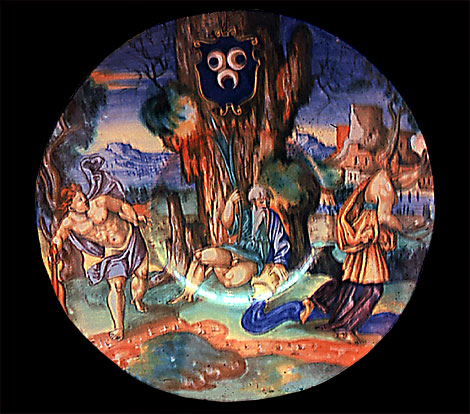Metamorphoses 1.452-567

This sixteenth-century plate from Venice shows some of the main characters in this story: Apollo, Peneus, Daphne, and a fairly spooky looking tree. For a better-known artistic rendtions of this story, see Bernini's famous Apollo and Daphne sculpture. Here are some questions to start you thinking about the passage:
- What is your first impression of Apollo? What words and rhetorical devices does Ovid use to influence the reader's feeling toward this god? Does this eighteenth-century French woodcut illustrating the story of Apollo and the python effectively portray Ovid's description?
- Point out some of the carefully structured contrasts in the lines introducing Cupid (463-73). Why do you think Ovid employs rhetorical structures we would expect to find in argumentation or debate rather than poetry? Do you think these are effective here? Why or why not?
- Compare the two arrows. How do their characteristics reflect their effects?
- How does Ovid introduce Daphne? What are her most striking characteristics? Do you find her sympathetic or not? What details of her appearance does Ovid stress? What role does her father, the river-god Peneus, play here? What verb is most associated with her?
- What imagery does Ovid use to portray what happens to Apollo when he first sees Daphne? In lines 497-502, Ovid employs language typically used by love poets; what impression does this language create here?
- Point out the most striking characteristics of Apollo's long speech. What effect is created when you realize that this is supposed to be delivered while running full speed? How is this effect magnified by the structure and language of lines 525-26? Do you think that this sixteenth-century painting gives a truer depiction of Apollo's real intentions than the god's own words?
- Explain the simile in lines 533-39? How does this pick up earlier structures and images used by Ovid in the story? What effect does this simile have on the reader?
- Ultimately, Daphne escapes Apollo only by a drastic metamorphosis (see this eighteenth-century French woodcut). What words in this transformation completely reverse the previous description of Daphne?
- In what ways do both Daphne and her pursuer remain the same after the metamorphosis? How does Ovid use this for comic effect?
- Apollo ends by connecting the laurel to the wreath he wears, to the doors of the house of Augustus on the Palatine, and to the Roman triumph. What effect does this historical dimension have on the story, especially when we consider that Augustus claimed he was under the special protection of Apollo, who had given him victory over Cleopatra at the Battle of Actium (see this coin which depicts the statue of Actian Apollo erected by Augustus in front of the Temple of Apollo he had built on the Palatine)?
- Is the ending straightforward or ambiguous? What did you think of the entire story?